
Snowline Gold Identifies New Gold Zone Near Its Valley Deposit and Provides Regional Exploration Update

Drilling along the eastern edge of the Valley intrusion intersects sheeted quartz veins with trace amounts of visible gold along an open, 500 m area, with assays pending.
Initial assay results from 2025 program at Valley reveal broad zones of gold mineralization outside of current MRE.
Regional drilling provides evidence of widespread gold fertility across all five RIRGS targets drilled outside of Valley to date in 2025. Assays pending for 17,500 m overall, with drilling ongoing.
Outcropping sheeted quartz veins in granodiorite discovered at the Ramsey target, Rogue Project, roughly 22 km west of Valley.
VANCOUVER, BC / ACCESS Newswire / August 7, 2025 / SNOWLINE GOLD CORP. (TSX-V: SGD) (US OTCQB: SNWGF) (the " Company " or " Snowline ") is pleased to provide updates to its ongoing exploration and development programs in the eastern Yukon. At Valley, sheeted quartz veins with visible gold are present in drill holes within a newly discovered and still open zone potentially 500 x 100+ m along the eastern boundary of the local intrusion (Figure 1), several hundred metres east of the current limit of the Valley Mineral Resource Estimate ("MRE") [1] (Figure 2). On the broader Rogue Project, of five additional reduced-intrusion related gold system ("RIRGS") targets drilled outside of Valley so far in 2025, all have now encountered trace instances of visible gold. Assays are pending for all regional holes. In addition, surface exploration has discovered sheeted quartz vein mineralization in granodiorite at Snowline's early stage "Ramsey" target, located at low elevations roughly 22 km west of Valley. To date, over 20,000 m have been drilled by the Company this year on the Rogue and Einarson projects, with drilling ongoing and assays pending for approximately 17,500 m.
"We have a lot to be excited about as initial assays come in for the 2025 drill season," said Scott Berdahl, CEO & Director of Snowline. "Late last season, drillhole V-24-115 gave indications that the eastern margin of the Valley intrusion could host an additional zone of strong RIRGS mineralization. Our current drilling shows increased quartz vein densities towards this eastern margin, accompanied by trace amounts of visible gold, along a wide corridor that is well outside of our previous drilling. On the broader Rogue Project, additional RIRGS targets demonstrate widespread gold fertility through drilling and through ongoing surface exploration. We await analytical results to determine the significance of these initial results.
"I would like to commend Snowline's field team on safe execution of such a rigorous exploration campaign to date in the midst of a busy and multi-faceted season. The various engineering and environmental studies thrown into the mix to advance our Valley deposit have not dampened the pace nor the enthusiasm of our team in getting out and taking big swings towards making additional discoveries across our prospective greenfield mineral property portfolio."
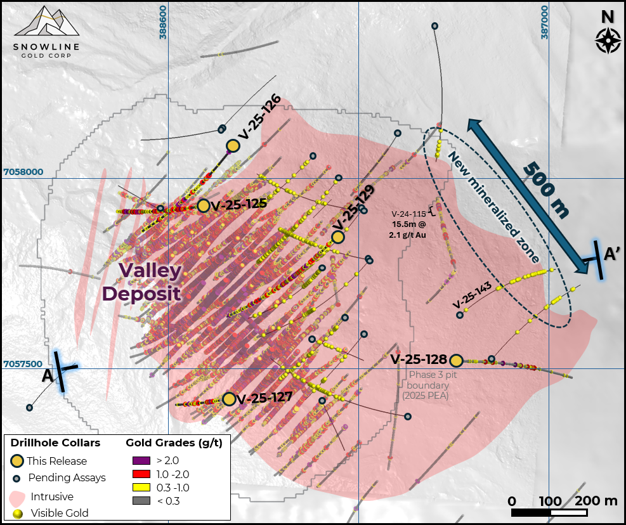
Figure 1 - Plan map of the Valley intrusion showing all drilling to date, including results from the first five holes received for 2025. Observations of visible gold in holes that have yet to receive analytical results are shown as yellow circles. The surface trace of Figure 2 is shown as A-A'. Note that 2025 holes are plotted above previous results for clarity, regardless of relative depths. The outline of the Valley intrusion corresponds to its expression at surface. See Snowline news release dated February 19, 2025 for further details on hole V-24-115.
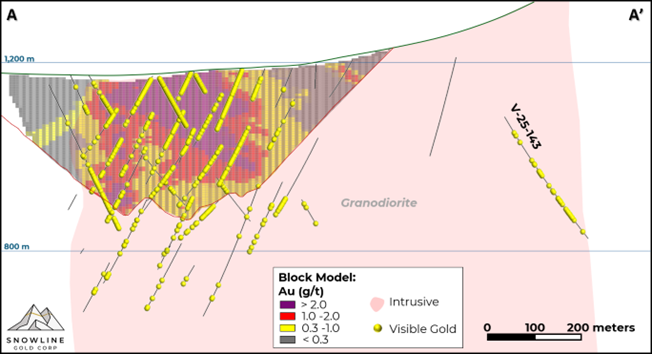
Figure 2 - Cross section A-A' showing the location of V-25-143 relative to all other drilling and the Phase 3 pit shell from the July 30, 2025 Rogue Project PEA. The surface trace of this section is shown on Figure 1.
VALLEY UPDATES, ROGUE PROJECT
Drilling: Over 11,500 m of drilling has been completed within and near the Valley deposit to date in 2025, and drilling is ongoing. The objectives of this program are: 1) to test potential expansion of the current MRE for Valley; 2) to test for new zones of high-grade mineralization within the Valley intrusion; and 3) to prepare for a future Prefeasibility Study ("PFS") by upgrading Inferred Resources to higher categories and obtaining additional geotechnical information.
Of note, a new zone of sheeted quartz veins has been identified along the previously untested eastern margin of the Valley intrusion, with abundant instances of trace visible gold observed within the veins (Figures 1, 2 and 3). The location of this mineralization at depth corresponds to the surface expression of the "Ridge" zone soil and talus fine gold anomaly, identified by the Company in early sampling (see Snowline's March 10, 2022 news release ). These observations await analytical results, which are necessary to assess the significance of the new zone of mineralization.
In addition, the Company has received results from its first five holes at Valley to date. These holes, V-25-125 through 129, reveal broad zones of anomalous gold mineralization outside of the current Valley MRE and, where inside the existing block model, will serve to inform potential recategorization of Inferred Mineral Resources (Figure 1, Table 1).
Valley Development: A rigorous program of geotechnical, geochemical, surface, groundwater and environmental testing is ongoing at Valley and related sites to support advancement of a future PFS and permitting.
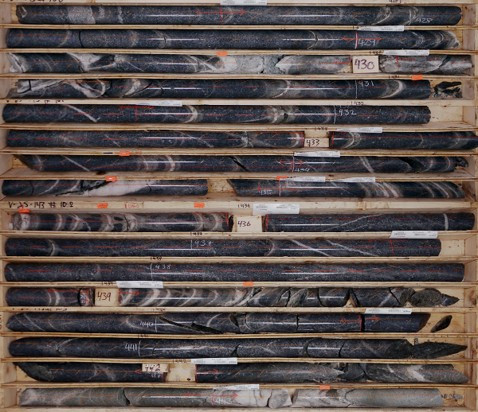
Figure 3 - V-25-143 drill core from 427.0 m to 443.5 m downhole. Light to intense sheeted quartz veins cut the Valley intrusion at multiple orientations, with varying alteration types around different veins. Similar mineralization occurs from roughly 326 to 443 m downhole, as well as in surrounding holes in an open, 500 m area along the eastern edge of the Valley intrusion which was previously assumed to be unmineralized. Vein thicknesses range from 5 mm to >5 cm. Minor bismuthinite and trace visible gold (denoted by orange flagging tape above the core) are present in the sheeted veins. Assays for this hole and others are pending.
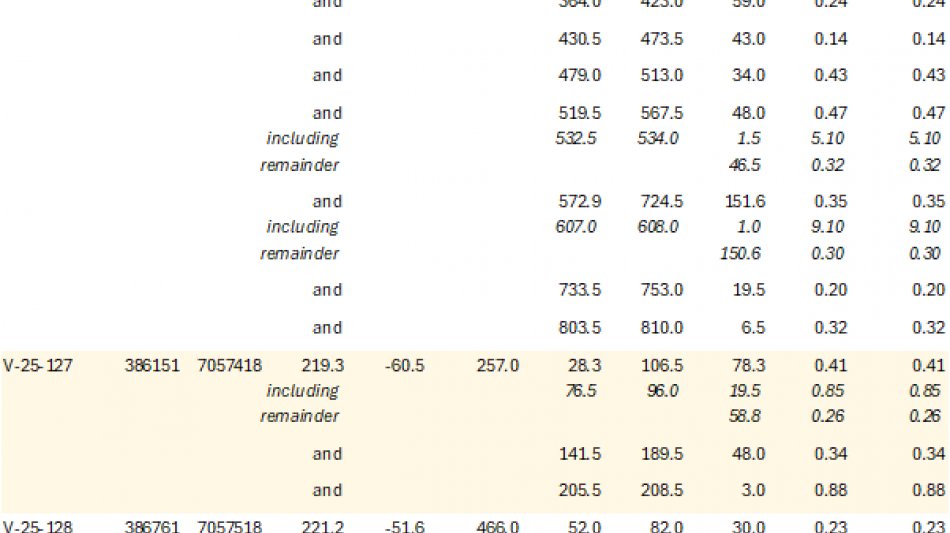
Table 1 - Anomalous gold intervals in drillholes V-25-025 through V-25-129 from the Valley deposit.
REGIONAL UPDATES, ROGUE PROJECT
Over 4,300 m of drilling has been completed to date in 2025 on the Rogue Project outside of the Valley deposit, on five additional targets. Rare instances of trace visible gold have been encountered in drill core from all five targets, in small (0.5-10 cm) quartz veins, consistent with the RIRGS deposit model. This regional exploration campaign is ongoing, with assays pending for all targets. Target locations are shown in Figure 4, and examples of intrusive drill core from the Duke, JP and Aurelius targets are shown as Figures 5, 6 and 7 respectively.
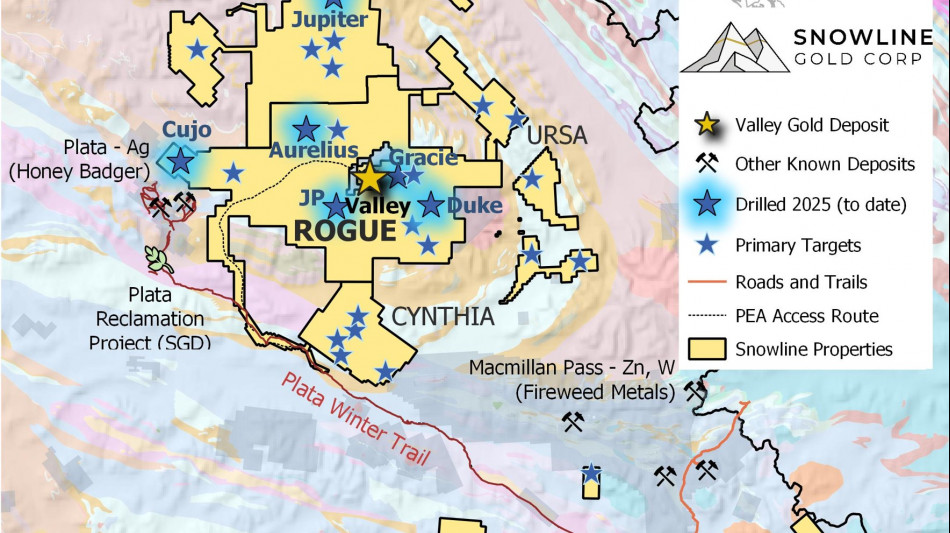
Figure 4 - Project location map for Snowline Gold's eastern Selwyn Basin projects: Rogue, Einarson, Ursa, Cynthia and Olympus, highlighting targets drilled to date during Snowline's 2025 exploration campaign.
Duke Target:
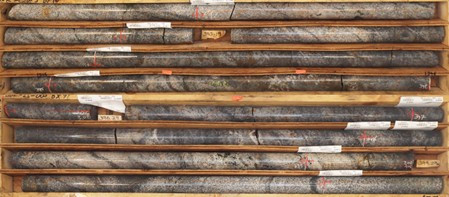
Figure 5 - DUK-25-003 drill core from 391.5 m to 400.3 m downhole. Mineralization at Duke includes disseminated acicular arsenopyrite within the intrusion and surrounding country rock. Minor bismuthinite and trace visible gold (denoted by orange flagging tape above the core) are present in the sheeted veins. Assays for this hole and all others from Duke are pending.
Duke is located roughly 11 km southeast of Valley. The host intrusion forms a 1.4 x 1.3 km multiphase stock. The full extent of the intrusion is not yet known. A north-south creek through the intrusion exposes similar outcrops with evidence of surface mineralization along a 3 km corridor.
The intrusion at Duke is characterized by porphyritic to equigranular granodiorites and diorites crosscut by multiple intrusive breccias that in all cases show quartz±sulphide veins with minor to trace bismuthinite, arsenopyrite, boulangerite, chalcopyrite, pyrrhotite, and tourmaline. Disseminated acicular arsenopyrite is also observed within the intrusive and country-rock volcanic units. Three sets of veins have been identified with distinct orientations. Three holes have been completed (1,331 m) in the first-ever drill testing of the target, with rare, trace instances of visible gold observed each hole. Assay results are pending for these holes.
JP Target:
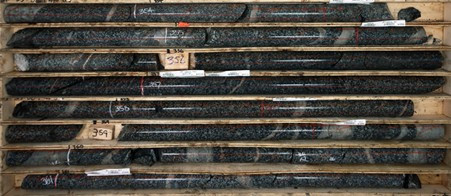
Figure 6 - JP-25-001 drill core from 353.7 m to 362.0 m downhole. Shallow-dipping quartz veins cut megacrystic syenite, in some cases with thick white alteration selvages. Vein thicknesses range from 5 mm to >5 cm. Minor bismuthinite and trace visible gold (denoted by orange flagging tape above the core) are present in the sheeted veins. Assays for this hole and others from JP are pending.
JP is another RIRGS target that forms part of the Rogue Plutonic Complex. It is located 8 km southwest of Valley, and 8 km south of the Valley access route envisioned in the recent Rogue Project PEA. It is characterized by a NE-elongated 1.2 x 0.7 km megacrystic syenite crosscut by smaller granodioritic dykes.
Mineralization is hosted in sub-horizontal quartz-sulphide veins, with densities varying between 1 and 3 veins per meter. These veins contain traces to massive aggregates of arsenopyrite, bismuthinite, pyrite, and pyrrhotite. Three holes have been completed as part of the first ever drill campaign done on this target (1,456 m). Rare, trace instances of visible gold have been identified within quartz veins in each hole. Assays are pending for all holes at JP.
Aurelius Target:
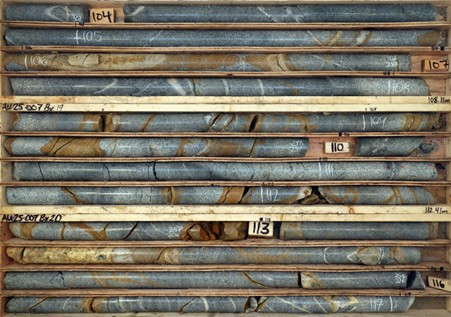
Figure 7 - AU-25-007 drill core from 103.8 m to 117.1 m downhole. Light to moderate sheeted quartz veins cut a granodiorite intrusion, with varying alteration types around different veins and selective oxidation. The hole is the first at Aurelius to intersect an intrusive stock and was cut short by technical issues. Assays for this hole and one other at Aurelius are pending, with plans for an additional hole to further test mineralization within this intrusion.
Two holes have been drilled so far at Aurelius as part of a Phase II drill program (535 m), following up on Phase I drilling in 2024. Of note, hole AU-25-007 intersected a medium-grained granodiorite containing sheeted quartz veins with varying levels of sulphides. Outcrops of similar granodiorite were identified 150 m south of this hole, but no veining was identified at surface. While trace visible gold was encountered in Phase I drilling, no visible gold has been observed to date within the intrusion. Assays are pending for all Phase II holes at Aurelius.
AU-25-007 didn't reach its target depth due to operational problems. The drilled bedrock interval (between 80 and 150 meters) contains two sets of veins, all of them with minor to trace pyrrhotite, pyrite, arsenopyrite, bismuthinite, and molybdenite. Vein density ranges between 2 to 5 veins per meter. A follow-up hole is planned before the end of the season to further test this newly-discovered instance of intrusion-hosted sheeted quartz veins.
Ramsey Target:
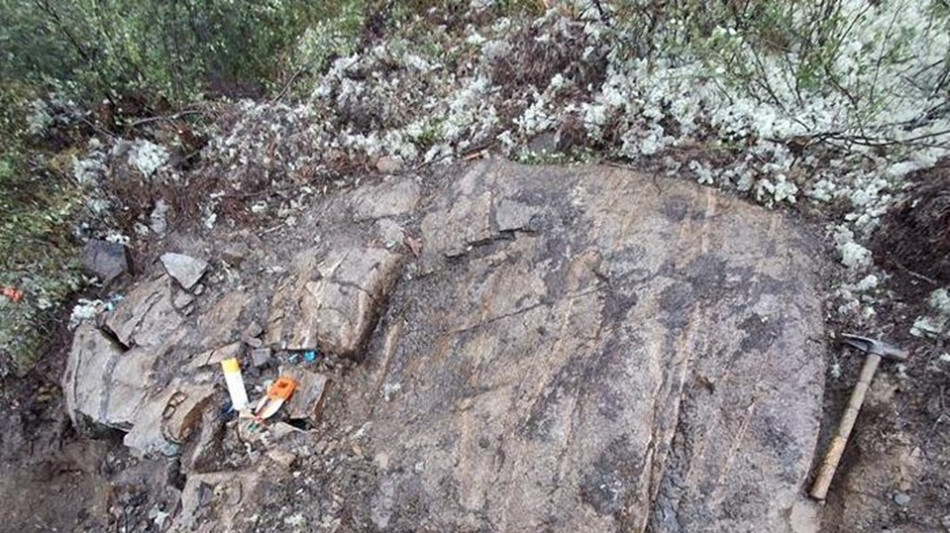
Figure 8 - Sheeted quartz veins in outcropping granodiorite at the Ramsey target, Rogue Project. The outcrop is the first instance of granodiorite exposed in bedrock encountered at Ramsey, which occupies a topographic low. For scale, the handle of the rock hammer on the right side of the image is roughly 50 cm long.
Surface prospecting and mapping at the Ramsey target has located outcropping sheeted quartz veins hosted in granodiorite. Owing to the covered nature of the target area, the character and extent of this quartz vein hosted mineralization and the granodiorite itself are not yet known. The outcrop has been channel sampled across its full 7 m width, with assays pending. On positive results, the Ramsey target may become a candidate for a late-season, Phase I drill program. Initial prospecting of the target area yielded visible gold in outcrop, hosted by thin, sheeted quartz veins through gabbro, with a selective grab sample returning 86.5 g/t Au (see Snowline news release dated May 2, 2024 ).
The Ramsey target is located 22 km west of Valley and roughly 4 km from the access corridor envisioned by the recent Rogue Project PEA. It has never been drill tested.
QA/QC
On receipt from the drill site NQ2-sized drill core was systematically logged for geological attributes, photographed and sampled at Snowline's "Forks" Camp. Sample lengths as small as 0.5 m were used to isolate features of interest, but most samples within moderate to strong mineralization were 1.0 m in length; otherwise, a default 1.5 m downhole sample length was used. Core was cut in half lengthwise along a pre-determined line, with one half (same half, consistently, dictated by orientation line where present or by dominant vein orientation where absent) collected for analysis and one half stored as a record. Field duplicates were collected at regular intervals as ¼ core samples by splitting the ½ core sent for sampling, leaving a consistent record of half core material from duplicate and non-duplicate samples alike. Standard reference materials and blanks were inserted by Snowline personnel at regular intervals into the sample stream. Bagged samples were sealed with security tags to ensure integrity during transport. They were delivered by expeditor to Bureau Veritas' preparatory facility in Whitehorse, Yukon. Sample preparation was completed in Whitehorse, with analyses completed in Vancouver.
Bureau Veritas is accredited to ISO/IEC 17025 and ISO9001 for quality management. Samples were crushed by BV to >85% passing below 2 mm and split using a riffle splitter. 250 g splits were pulverized to >85% passing below 75 microns. A four-acid digest with an inductively coupled plasma mass spectroscopy (ICP-MS) finish was used for 59-element analysis on 0.25 g sample pulps (BV code: MA250). All samples were analysed for gold content by fire assay with an atomic absorption spectroscopy (AAS) finish on 30 g samples (BV code: FA430). Any sample returning >10 g/t Au was reanalysed by fire assay with a gravimetric finish on a 30 g sample (BV code: FA530).
For the purposes of this release, contiguous mineralized intervals at Valley are defined as runs of mineralization with no break >5.0 m assaying entirely
ABOUT SNOWLINE GOLD CORP.
Snowline Gold Corp. is a Yukon Territory focused gold exploration and development company with mineral claim portfolio covering roughly 360,000 ha (3,600 km 2 ). The Company is advancing its Valley gold deposit-a large, low-strip, near surface, >1 g/t Au bulk tonnage gold system located in the eastern Yukon-while continuing regional exploration of surrounding targets on the Rogue Project and the broader district in the highly prospective yet underexplored Selwyn Basin.
Valley hosts an open MRE of 7.94 million ounces gold at 1.21 g/t Au Measured & Indicated (in 204.0 million tonnes) and an additional 0.89 million ounces gold Inferred at 0.62 g/t Au (in 44.5 million tonnes) [2] , with a cut-off grade of 0.3 g/t Au. Results of a Preliminary Economic Assessment ("PEA") of Valley suggest the potential for the deposit to support a long-life mining operation with a strong production profile and low production costs. The MRE and PEA are supported by the recent technical report for Rogue, prepared in accordance with NI 43-101 standards, entitled "Independent Preliminary Economic Assessment for the Rogue Project Yukon, Canada," dated July 30, 2025, with an effective date of March 1, 2025, and available on SEDAR+ and the Company's website.
Snowline's project portfolio sits within the prolific Tintina Gold Province, host to multiple million-ounce-plus gold mines and deposits across the central Yukon and Alaska. The Company's comprehensive first-mover position and extensive exploration database provide a distinct competitive advantage and a unique opportunity for investors to be part of multiple discoveries, the advancement of a significant gold deposit, and the creation of a new gold district.
QUALIFIED PERSON
Information in this release has been prepared under supervision of and approved by Sergio Gamonal, M.Sc., P. Geo., Chief Geologist for Snowline Gold Corp, as Qualified Person for the purposes of National Instrument 43-101.
ON BEHALF OF THE BOARD
Scott Berdahl
CEO & Director
For further information, please contact:
Snowline Gold Corp.
+1 778 650 5485
[email protected]
Neither TSX Venture Exchange nor its Regulation Services Provider (as that term is defined in policies of the TSX Venture Exchange) accepts responsibility for the adequacy or accuracy of this release.
CAUTIONARY NOTE REGARDING FORWARD-LOOKING STATEMENTS
This news release contains certain forward-looking statements, including statements about the Company's work programs, results, surface work, advancement of studies and permitting, the completion of a potential PFS, the significance of visible gold in drill core, mineral resource estimates, projected mining plans costs, projected life of mine, and plans for exploring and expanding a new greenfield, district-scale gold system. Wherever possible, words such as "may", "will", "should", "could", "expect", "plan", "intend", "anticipate", "believe", "estimate", "predict" or "potential" or the negative or other variations of these words, or similar words or phrases, have been used to identify these forward-looking statements. These statements reflect management's current beliefs and are based on information currently available to management as at the date hereof.
Forward-looking statements involve significant risk, uncertainties and assumptions. Many factors could cause actual results, performance or achievements to differ materially from the results discussed or implied in the forward-looking statements. Such factors include, among other things: risks related to uncertainties inherent in drill results and the estimation of mineral resources; and risks associated with executing the Company's plans and intentions. These factors should be considered carefully, and readers should not place undue reliance on the forward-looking statements. Although the forward-looking statements contained in this news release are based upon what management believes to be reasonable assumptions, the Company cannot assure readers that actual results will be consistent with these forward-looking statements. These forward-looking statements are made as of the date of this news release, and the Company assumes no obligation to update or revise them to reflect new events or circumstances, except as required by law.
[1] Please see technical report titled "Independent Preliminary Economic Assessment for the Rogue Project Yukon, Canada" dated July 30, 2025 with an effective date of March 1, 2025, available under the Company's profile at www.sedarplus.com and available on the Company's website at www.snowlinegold.com .
[2] Mineral resources are not mineral reserves and do not have demonstrated economic viability. The estimate of mineral resources may be materially affected by metal prices, economic factors, environmental, permitting, legal, title, or other relevant issues.
SOURCE: Snowline Gold Corp.
View the original press release on ACCESS Newswire
X.Gaboury--SMC


 London
London

 Manchester
Manchester
 Glasgow
Glasgow
 Dublin
Dublin
 Belfast
Belfast
 Washington
Washington
 Denver
Denver
 Atlanta
Atlanta
 Dallas
Dallas
 Houston Texas
Houston Texas
 New Orleans
New Orleans
 El Paso
El Paso
 Phoenix
Phoenix
 Los Angeles
Los Angeles


